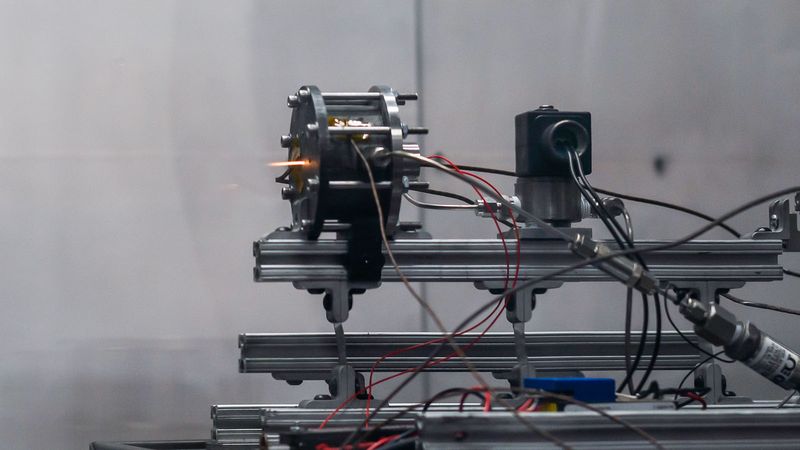
The Miniaturized Green End-Burning Hybrid Propulsion System for CubeSats is shown in this image during a test fire at an SDL facility on USU’s Innovation Campus. (Photo Credit: SDL/Allison Bills)
Utah State University’s Space Dynamics Laboratory announced today that it has been awarded a patent for developing a miniaturized propulsion system for CubeSats. The invention responds to the space industry’s increased interest in small satellite on-orbit maneuverability.
The ability to maneuver CubeSats in orbit offers many benefits, including enhanced satellite versatility and effectiveness. With propulsion systems onboard, CubeSats can make precise orbital adjustments, enabling mission flexibility and responsiveness to real-time data.
Maneuverable CubeSats can engage in formation flying and swarming for cooperative missions, optimize communication coverage, and actively avoid collisions with other satellites and space debris, contributing to space safety and sustainability. Additionally, repositioning capabilities extend satellite lifespan, while controlled deorbiting ensures responsible satellite disposal. These propulsion systems also provide valuable testing potential for future satellite technologies and offer hands-on education opportunities for students and researchers in space science and engineering.
Key challenges in small satellite propulsion include limited space onboard and mass contrariness. Measuring just 10 centimeters on all sides, CubeSats have limited propellant capacity, which affects their operational lifespan and orbital maneuverability. The new propulsion system is designed to fit compactly within the confines of CubeSats without compromising their core mission and capabilities.
Inventors of the Miniaturized Green End-Burning Hybrid Propulsion System for CubeSats — SDL engineers Tyson Smith, Zachary Lewis, Kurt Olsen, SDL scientist and retired USU professor Stephen Whitmore, and inventor Marc Anthony Bulcher — have been solving considerable technical challenges associated with propelling very small spacecraft for years. The new patent leverages a SmallSat propulsion invention awarded last year to SDL and Smith, Lewis, Olsen, and Whitmore.
“Small satellites are increasingly hailed for their versatility and cost-effectiveness, but their potential has been defined by their inherent limitations in space, mass, and power, demanding propulsion solutions that are compact, lightweight, and highly efficient,” said Olsen. “The new invention addresses these issues by creating propulsion that enables small spacecraft to burn safe, solid fuel in a controlled manner at thrust levels appropriate to their smaller mass.”
The team also considered onboard power constraints, spacecraft complexity, and thermal management when designing the new propulsion system.
“Small satellites often face power limitations, necessitating propulsion systems that strike a delicate balance between efficiency and power consumption,” explained Olsen. “We also focused on developing a propulsion solution that was simple and reliable while maintaining high performance standards.”
Their invention uses a mix of solid and liquid fuel that, unlike much of the conventional rocket fuel used today, is harmless to humans and restartable.
“SDL patents inventions developed within our core competencies to enable licensing opportunities that will advance the state of the art and provide broader market adoption of those inventions,” said Dale Andersen, SDL’s general counsel and patent attorney. “SDL inventors continue to foster innovations that enable our customers to apply leading-edge technologies to their critical missions.”
Headquartered on Utah State University’s Innovation Campus in North Logan, UT, the Space Dynamics Laboratory is a nonprofit organization and a Department of Defense University Affiliated Research Center owned by USU. More than 1,000 dedicated SDL engineers, scientists, business professionals, and student employees solve technical challenges faced by the military, science community, and industry and support NASA’s vision to explore the secrets of the universe for the benefit of all. SDL has field offices in Albuquerque, NM; Chantilly, VA; Dayton, OH; Huntsville, AL; Ogden, UT; and Stafford, VA. For more information, visit www.sdl.usu.edu.
Contact
- SDL Public Relations
- (435) 713-3054
- pr@sdl.usu.edu